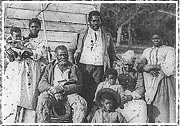Jennifer Hallam in Thirteen:
 When Africans were taken from their homes and forced into slavery, they were separated from mothers, fathers, sisters and brothers and were torn from extensive kinship networks. Enslaved in the British colonies of North America or the free states of the American Union, the ability of Africans to reestablish nuclear families and familial support systems depended on many factors including the needs and desires of the slave owner. As the circumstances of slavery changed across time and place, the opportunities for slaves to marry, have children, and create stable family units fluctuated.
When Africans were taken from their homes and forced into slavery, they were separated from mothers, fathers, sisters and brothers and were torn from extensive kinship networks. Enslaved in the British colonies of North America or the free states of the American Union, the ability of Africans to reestablish nuclear families and familial support systems depended on many factors including the needs and desires of the slave owner. As the circumstances of slavery changed across time and place, the opportunities for slaves to marry, have children, and create stable family units fluctuated.
Slave trade to the original thirteen colonies was slow and sporadic. In places like New York and Virginia, where small farming units were the norm, slaves were bought by handfuls rather than shiploads. The preference for male laborers limited the ability of most black slaves in early colonial society from developing relationships with black women. Among the Atlantic Creole population in New Amsterdam, however, a more balanced male to female ratio made as many as twenty-six marriages possible. These unions took place within the Dutch Reformed Church. The church became an institution through which New Amsterdam blacks were able to form independent familial units. In addition to marriage papers, archives of the Dutch Reformed Church contain baptism records that list children according to fathers rather than owners and name black godparents as witnesses.
Enslaved blacks attempted to provide for their family members financially, as well as spiritually. At a time when slavery was still a concept rather than a legal institution, blacks from New Amsterdam to the Chesapeake Bay used the courts to ensure the well-being of family members. Numerous slaves made bequests of property to wives or children in wills.
More here. (Throughout February, at least one post will be dedicated to honoring Black History Month. The theme this year is: The Family)
